Aloe Veras are known for their outstanding healing properties. Besides, they are easy to grow. Despite being low-maintenance plants, Aloes face some complications. The rotting base is one of them. Today, we will discuss the reasons behind Aloe vera rotting at the base.
Root rot and basal stem rot are the primary causes of Aloe Vera rotting at the base. Base rot in aloe vera primarily happens due to overwatering, so you should always keep the growing medium dry, maintain a warm temperature and ensure proper drainage to prevent rotting.
To know more about these, read this article till the end. This guide has everything related to a rotten Aloe Vera base. We will also share some care tips to prevent such conditions.
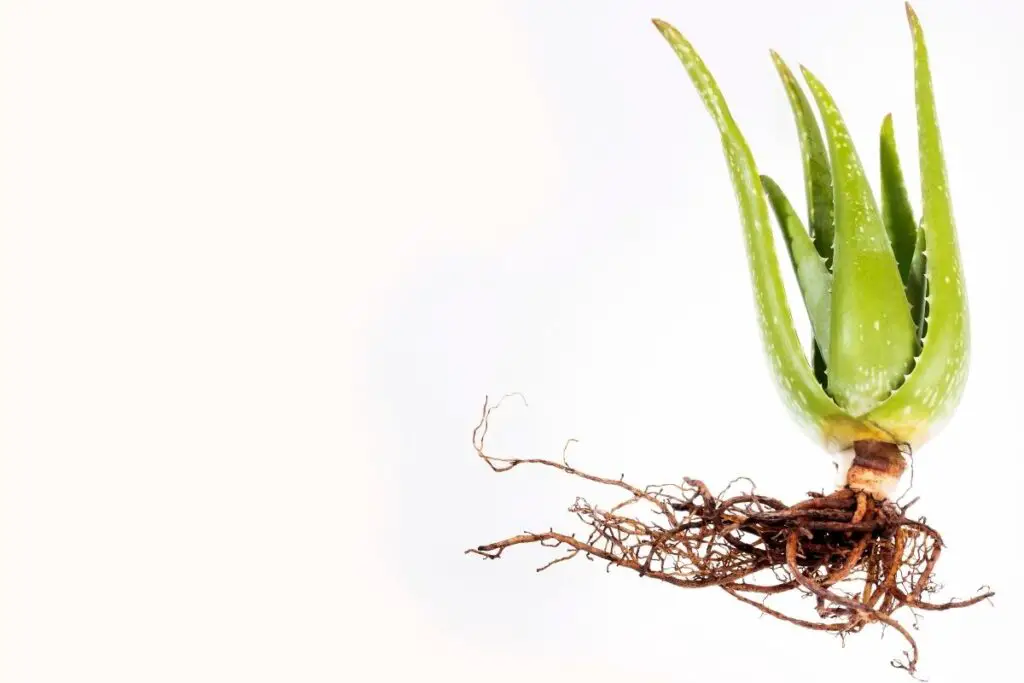
Why is my Aloe Vera rotting at the base?
There are not many reasons behind this problem.
Generally, when we hear the sentence “rotting at the base,” the first thing that strikes us is excessive moisture in the soil.
Excessive soil moisture occurs because of our negligence.
Other than that, some diseases can also result in a rotting base.
Let’s get into the reasons in detail to clear out the confusion.
Root rot
Root rot is the first and foremost cause that strikes us when the Aloe rots from the base.
It causes due to the combination of waterlogged soil and fungus infection.
Root rot is caused by various fungi, namely, Armillaria mellea, Clitocybe tabescens, Fusarium, and many other oomycetes like Pythium, Phytophthora, etc.
Aloes grow in dry and hot climates in their native land.
They will have sandy, well-drained, and well-aerated soil.
If you grow Aloe in your garden and fail to give them such growing conditions, it will become vulnerable to such diseases.
Belonging to dry areas, the Aloes don’t require frequent watering.
If you provide too much water, the plant will undergo overwatering.
If overwatering remains in the plant for extended periods, it will invite all sorts of fungi and result in root rot.
Though you can save the plant if the root rot symptoms are mild, it is difficult if the condition is severe.
The container plants suffer more than the grounded plant because, in the former, the soil at the base doesn’t dry out.
Also read: How To Water Aloe Vera Plant? (How often, Summer, Winter)
Other reasons for root rot besides overwatering are:
Looking for gardening supplies? We have tested 100's of products before recommending them to you guys. Check out our best pick below:
| Image | Gardening Supplies | Best Price? |
|---|---|---|
 Top
Top Top
Top | Raised Garden Bed Kit | Check On Amazon |
 | XLUX Soil Moisture Meter, Plant Water Monitor, Soil Hygrometer Sensor for Gardening, Farming, Indoor and Outdoor Plants, No Batteries Required | No Results |
 Top
Top Top
Top | 82 Pcs Garden Tools Set and Extra Succulent Tools Set | Check On Amazon |
 | Joeys Garden Expandable Garden Hose with 8 Function Hose Nozzle, Lightweight Anti-Kink Flexible Garden Hoses, Extra Strength Fabric with Double Latex Core, (50 FT, Black) | No Results |
 Top
Top Top
Top | Dual Chamber Compost Tumbler | Check On Amazon |
 Top
Top Top
Top | Sunnyglade Plant Stakes | Check On Amazon |
 Top
Top Top
Top | Organic Cold Pressed Neem Seed Oil | Check On Amazon |
 Top
Top Top
Top | Mighty Mint Gallon :-Insect and Pest Control Peppermint Oil | Check On Amazon |
 Top
Top Top
Top | Scotts DiseaseEx Lawn Fungicide | Check On Amazon |
 Top
Top Top
Top | Jacks Classic 20-20-20 All Purpose Fertilizer | Check On Amazon |
 Top
Top Top
Top | 30,000 Seeds Pollinator Attracting Wildflower Mixture | Check On Amazon |
 Top
Top Top
Top | Survival Vegetable Seeds Garden Kit-Over 16,000 Seeds | Check On Amazon |
Poor drainage
If you water the Aloes correctly but, the soil doesn’t drain enough water, the soil around the roots will remain wet for prolonged periods without your knowledge.
Over that, if you continue normal watering, it will lead to root rot.
Also read:
- What Type Of Soil For Aloe Vera Plant? (+Ideal Soil Mix)
- What Pot Is Best For Aloe Vera Plant? (Pot Type, Size & More)
Small container
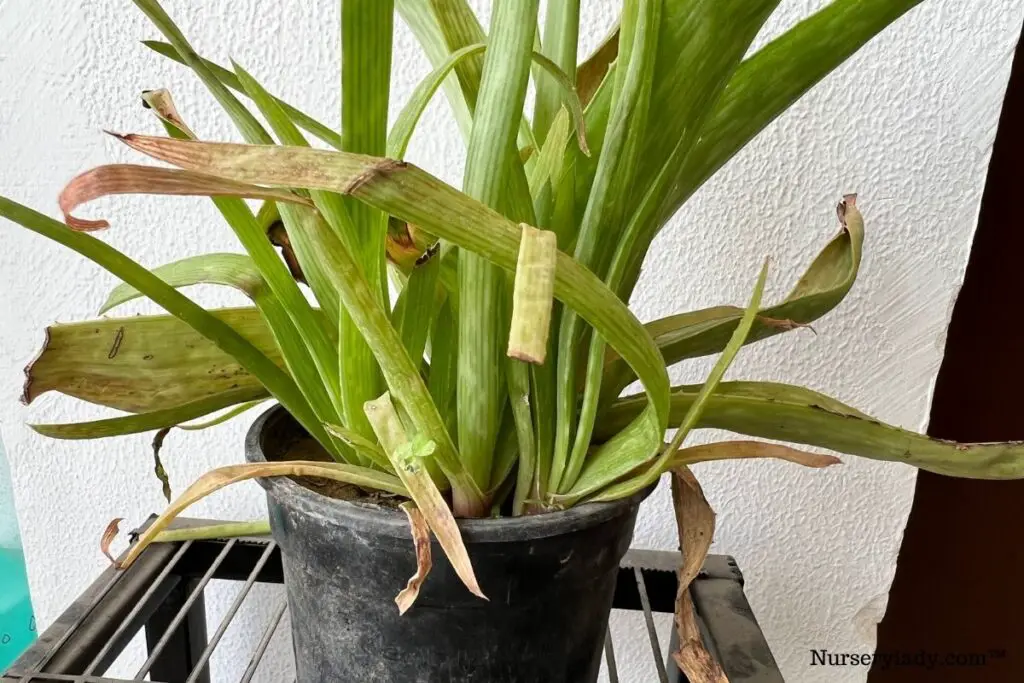
When you use a small container for Aloes, the roots grow in a circular motion and become compact.
In such conditions, the water will stay in the soil.
Such tight conditions won’t let the soil drain the water properly.
Even if the soil looks dry from above, the moisture didn’t drain yet.
And, if you continue to water over such conditions, the roots will stay wet all the time and encourage fungal development.
Slowly the rotting will spread from the roots to the stem base and damage the whole plant.
Hypothermia
The Aloes will get hypothermia and worsen if a cold climate accompanies wet soil.
This happens mostly when the temperature starts dipping below 55°F.
The soil has already started getting cold due to the outside temperature.
Additionally, the soil will become soggy if you water them too often.
As a result, soggy and cold soil will be an accurate breeding place for root rot fungus. Slowly, the base of the plant will begin to rot.
Pathogenic infections
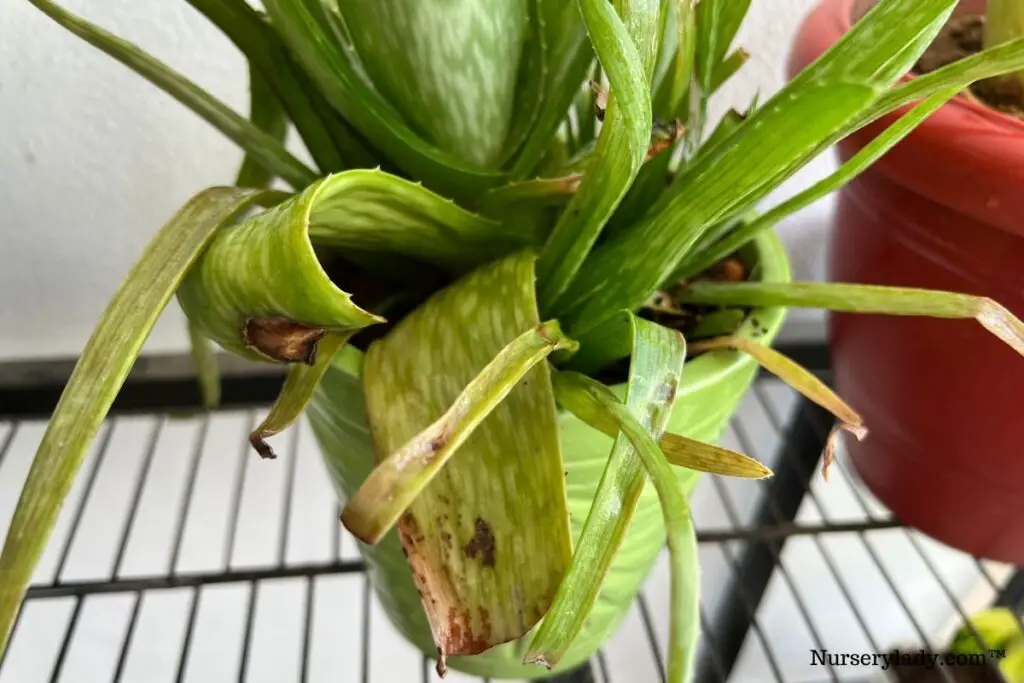
You have done nothing wrong, but still, your plant will rot at the base.
You might have used an old container that was contaminated with the same disease and didn’t even wash it properly.
Simply, the fungus will transfer from the container to the plant and rot the roots and the base.
Signs:
- Leaves turning discolored, soft, and mushy
- Stem exposed from the bottom
- The leaves and stems at the base are rotting
- The base of the plant and the soil release a foul smell
How to save the plant?
- Take the plant out of the container. Be careful not to harm the roots.
- Remove all the dead, damaged, soft, mushy, and dark brown roots. Sometimes, all the roots will need trimming from the plant.
- After that, prune off the infected parts, i.e., the leaves and stems at the base. They, too, will damage and rot.
- Let the plant form callous for a few days. After some days, you will find that the cut portion has hardened, which means it has healed. It is an important step because if you plant it without healing, it will again rot.
- Now, repot the plant in a new container with new, well-drained soil. If the rotting occurred due to overwatering, you could use the old pot, but you must clean it with bleaching powder and soapy water.
- If the rotting is caused due to fungal infection, replace the container. Ensure that the pot has drainage holes.
- While making the soil mix, add a little bit of water to moisten it. But don’t use too much.
- If a fungal disease attacked your plant, prefer spreading some fungicide in the roots. It will eliminate the fungi and prevent further attacks.
- Sprinkle some rooting hormone at the base of the plant for fast rooting.
- Fill the container with the soil mix, place your plant in it and cover the sides with the remaining soil. Cover only the root area and not the leaves.
- Let it stay under filtered sunlight and water the soil only by misting. You can also water after 2-3 days.
Basal stem rot
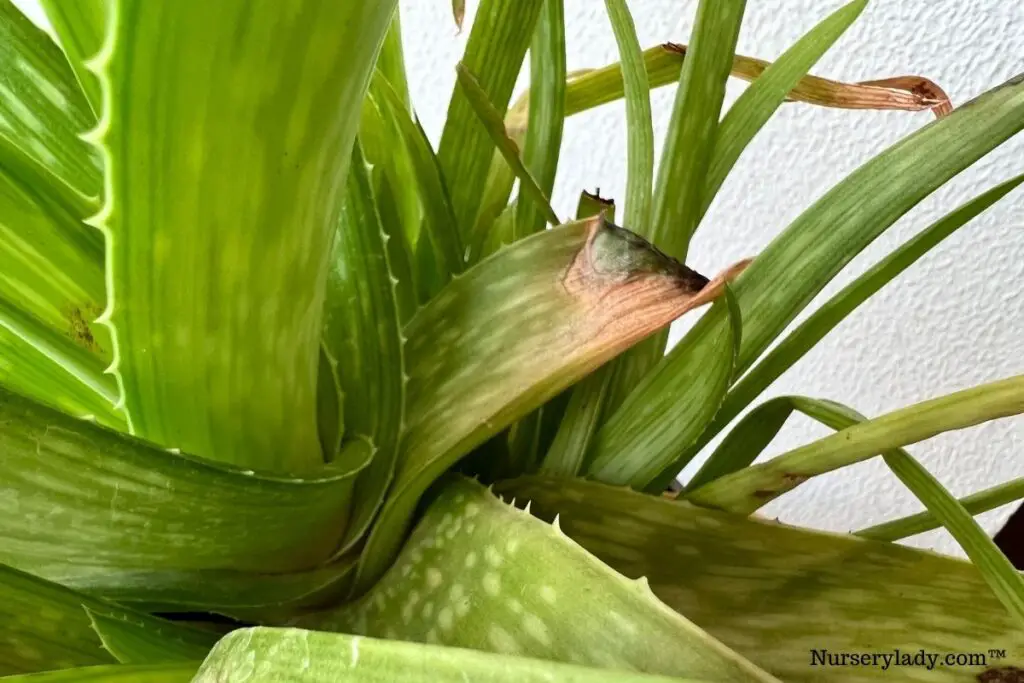
Another condition where the base of the Aloe Vera plant will rot is basal stem rot.
It is generally a fungal disease.
The fungal infection is caused by the mycotoxins, further produced by the fungus Fusarium spp.
They emerge and attack the Aloe Vera plant mostly during cold weather.
The situation will be worse if the soil remains cold and soggy at the same time.
The fungus will love to stay in the soil of your Aloe Vera plant if it’s wet and cold.
The symptoms of basal stem rot include:
- Black dark spots on the leaves
- The base of the plant will first become reddish-brown
- Over time, the plant base will become black and rotting signs will be visible.
How to save the plant?
Though the disease can kill your plant, you can still save it if you get to spot the signs at the initial stage.
You have to dig the plant to check the roots’ condition.
If the roots are mushy and dark brown, it is due to this problem.
If you catch the problem initially, you can take a stem cutting from above the rotten area and save the plant.
Prune all the infected roots from the plant and dispose of them in the dustbin.
Don’t throw them near your garden or use them as compost.
If there are any healthy roots left, you can save the plant.
- Search for and cut off the infected leaves and stems and dispose of them the same way.
- Don’t use the same old container or the soil as it got contaminated by the fungus.
- Take a new container with drainage holes and well-drained soil.
- Before planting the plant, spray some fungicide on the roots to eliminate leftover spores and prevent further development.
- Repot the plant in the new container.
- Don’t water them immediately. Wait for some days and start with less watering.
- Don’t expose them to direct sunlight until they show signs of recovery.
Base rot disease
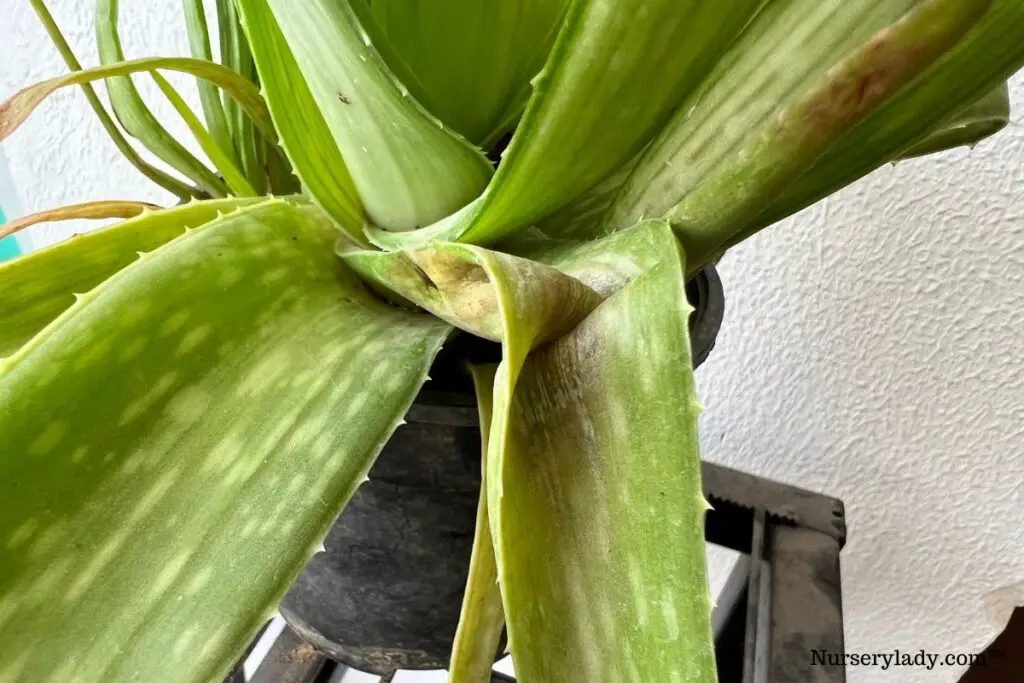
Base rot disease is a very serious disease in Aloe Veras as it results in the deterioration of the quantity and quality of the Aloe Vera leaves.
It occurs when there is the high moisture content in the soil.
The infection is mostly visible in the old and matured plants.
The leaves show yellowish-brown rotting spots, and over time, the problem worsens due to which the leaves droop and fall off.
The Aloe vera base and the bottom leaves undergo this problem the most because these parts are close to the soil.
The disease will slowly pass from the base to the other healthy parts and lead to partial or complete defoliation.
Research says five different fungi were shortlisted and held responsible for this disease, namely:
- Plectosphaerella cucumerina
- Mammaria echinobotryoides
- To rule herbarium
- Aspergillus verrucosa
- Fusarium oxysporum
After 6 days of inoculation, the plants showed full base rot disease in plants infected by Plectosphaerella cucumerina, Fusarium oxysporum, and Torula herbarum.
The other fungi showed moderate signs.
The fungi Plectosphaerella cucumerina is the most dangerous fungi that show signs within 6 days.
Fusarium oxysporum shows damage signs within 7 days.
Torula herbarum is as dangerous and aggressive as Plectosphaerella cucumerina.
Mammaria echinobotryoides fungi can show very slow signs of base rot.
Aspergillus verrucosa was slower than the Mammeria echinobotryoides fungi.
How to save the plant?
You have to do the thing as you did in the previous situations.
- If the problem is mild, you can save the plant by removing the damaged parts, applying some fungicide, and repotting it in new soil and container.
- Let them have filtered sunlight, and don’t start watering immediately. Wait for some days to water. As this disease is very serious, you must be very careful, watch the signs carefully and treat the problem as required by the plant.
- But if the problem is severe, which will be normal if your plant is affected by the fungi Plectosphaerella cucumerina, Fusarium oxysporum, and Torula herbarum, you might have to discard your whole plant.
How to take care of the Aloe Vera plant?
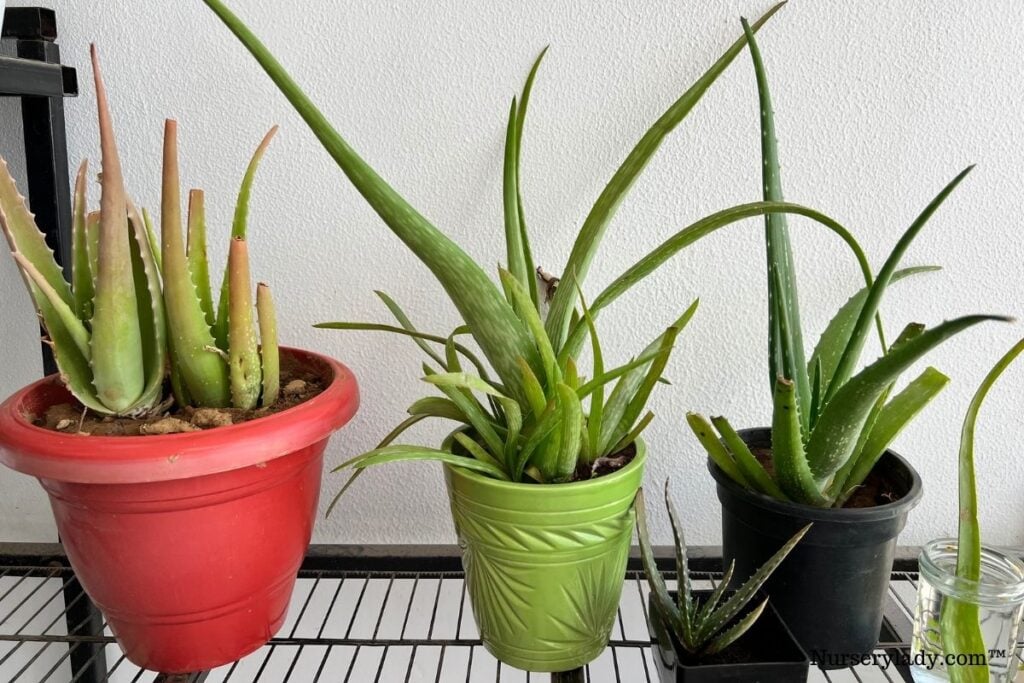
Taking good care of Aloe Vera can save the plant from various unfavorable conditions.
Since the main reason behind the base rotting is the high level of moisture, you must know how much moisture you should provide your plant.
Though the plant survives in neglect, you should know their basic needs and provide them with them in time.
Let’s learn the basic care tips for keeping an Aloe Vera plant healthy:
| Factor | Care Tips |
|---|---|
| Light | Aloes must receive daily 4 to 5 hours of sunlight. It would be best if they receive the direct sun in the morning. You should give them some shade to protect them from the harsh mid-day and afternoon sun. Adequate sunlight can keep the soil dry and prevent fungus. |
| Water | Before you provide the plant with enough water, you should check the soil’s moisture level. If the top 2-3 inches are dry, you can water them. Also, try to feel the soil through the drainage holes. Water if the soil is dry. |
| Soil | Always use well-drained soil to avoid prolonged dampness. The soil should be gritty and sandy. You can use a mixture of garden soil, coarse sand, and perlite. You can even add some small stones or pebbles at the bottom to prevent the soil or debris from blocking the drainage. |
| Pot | If you are using a container, ensure that it contains enough drainage holes. Use terracotta pots to help more in the draining process. |
| Temperature | Maintain a temperature range between 55 and 75°F. Aloes cannot tolerate cold. So, you must protect them from the cold and give them warmth. Never bother the Aloes with heavy watering during cold temperatures. Otherwise, it can cause hypothermia and even encourage various fungi. |
| Fertilization | Sometimes, over-fertilization can encourage fungus development. So, make sure you don’t over-feed. Fertilize Aloe Veras occasionally during the growing months only. |
| Air circulation | Since the fungi enjoy wet and cold or damp and humid, the surrounding of the Aloes must have adequate sunlight and enough air circulation. It also helps to reduce the humidity levels, dries out the soil faster, warms up the plant, and prevents the staying of fungus. |
Final thoughts
Though there are a few reasons behind Aloes rotting at the base, still it can be dangerous and life-threatening for the Aloe Vera plant. You should always take care and keep your plant healthy and dry.
Sometimes, unhealthy, weak, and insect-infested plants will also invite these fungi, resulting in base, stem, and leaf rot. So, you must observe your plant daily and watch out for the signs of pest infestations.
Don’t ever keep your plant wet for prolonged periods. If you have ever mistakenly increased the moisture content in your plant, take steps to dry them out quickly.
If your plant has issues like root rot, basal stem rot, or base rot disease, you should closely inspect the plant’s condition and take immediate steps as suggested.
Base rotting is not the end of your plant. If you are lucky and attentive enough, you can spot the early damage signs at the initial stage, and by taking quick steps, you can help your plant come back.
Reference: NCBI, New York Botanical Garden, University of New Hampshire, University of Florida, Wikipedia.
